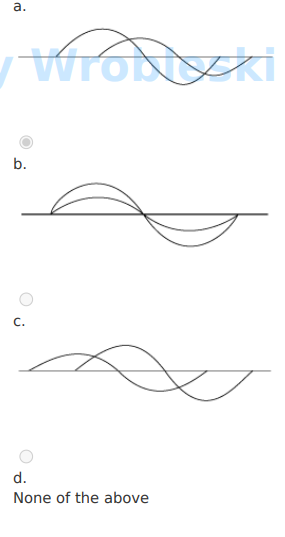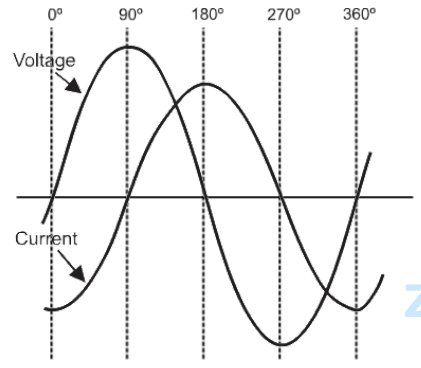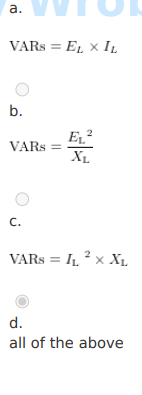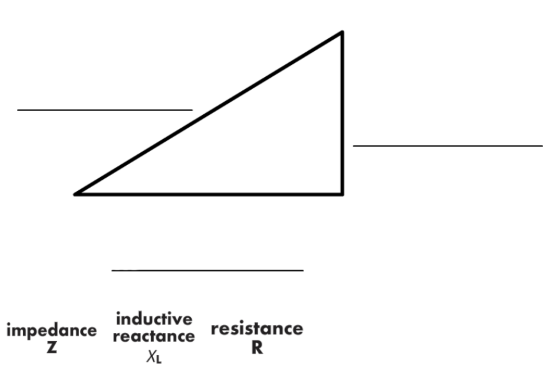-
When a steady direct current flows through a coil, the only opposition to the flow of current is the resistance
of the wire from which the coil is made.
Select one:
True
False
The correct answer is 'True'.
-
Alternating current flowing through a coil is opposed by two factors, resistance (R) and inductive reactance
(X ).
Select one:
True
False
The correct answer is 'True'.
-
? is the induction of voltage or CEMF that opposes the current flow in a coil.
a.
Impedance
b.
Inductive reactance
c.
Resistance
d.
Skin effect
The correct answer is: Inductive reactance
-
The total current-limiting effect of the inductor is a combination of the inductive reactance and resistance of
the inductor.
Select one:
True
False
The correct answer is 'True'.
-
The total current-limiting effect of an inductor is called ? and is symbolized by the letter ? .
a.
counter electromotive force / C
b.
impedance / Z
c.
inductive reactance / X
d.
resistance / R
The correct answer is: impedance / Z
-
Select the equation for determining the total impedance in an inductive and resistive circuit.
a. Z = XL x R
b. Z = XL + R
c. Z = XL^2 + R^2
d. Z = √XL^2 + R^2
The correct answer is: d. Z = √XL^2 + R^2
-
A circuit has a resistance of 10 ohms and a voltage of 120 volts. How much current flows?
Answer:
The correct answer is: 12 A
-
A circuit has an impedance of 5 ohms and a voltage of 100 volts. What is the current flow?
Answer:
The correct answer is: 20 A
-

Which waveforms correctly show current and voltage to be “in-phase”?

The correct answer is: b.
-
In most AC circuits, the current and voltage are ? .
a.
in-phase
b.
out-of-phase
c.
purely inductive
d.
purely resistive
The correct answer is: out-of-phase
-

These sine waves indicate voltage and current ? out-of-phase.
a.
30°
b.
45°
c.
60°
d.
90°
The correct answer is: 45°
-
There can be a phase difference between voltage and current in DC circuits.
Select one:
True
False
The correct answer is 'False'.
-
The equation for finding power in a circuit when the current and voltage are known is ? .
a.
P = E x I
b.
P = E^2 / R
c.
P = I x R
d.
P = I^2 x R
The correct answer is: P = E x I
-

Drag the appropriate voltage and current sine wave and locate it to show the relationship of voltage and
current over a complete cycle for a purely inductive circuit.
no answer
-
In a pure resistive circuit, the true power (or watts) is equal to the product of the ? and ? .
a.
current / resistance
b.
current / voltage
c.
voltage / resistance
d.
reactance / current
The correct answer is: current / voltage
-
An electrical measurement called VARs is used to measure ? power.
a.
apparent
b.
peak
c.
reactive
d.
true
The correct answer is: reactive
-
VARs are equal to the amount of current flowing through a(n) ? part of a circuit times the voltage applied
to the ? part of the circuit.
a.
inductive / inductive
b.
inductive / resistive
c.
resistive / inductive
d.
resistive / resistive
The correct answer is: inductive / inductive
-

The equation to find the VARs in an inductive circuit is ? .
The correct answer is: all of the above
-
? power in a circuit is the voltage at a certain instant multiplied by the current at that same instant.
a.
Average
b.
Effective
c.
Instantaneous
d.
RMS
The correct answer is: Instantaneous
-
Match the correct word to accurately complete the sentences below.
In an AC circuit, when both the current and voltage of the circuit have a negative value, the
power of this circuit is ? .
In an AC circuit, when both the current and voltage of the circuit have a positive value, the
power of this circuit is ? .
In an AC circuit, when current of the circuit is ? and the voltage of the circuit is negative,
the power of this circuit has a negative value.
In an AC circuit, when the current of the circuit is negative and the voltage of the circuit is
zero, the power of this circuit has a ? value.
possible answers
positive
negative
zero
postive
postive
postive
zero
-
When the current and voltage are ? , one may be positive while the other is negative.
a.
in-phase
b.
out-of-phase
c.
None of the above
The correct answer is: out-of-phase
-
When the current and voltage on a circuit reach maximum values at the same time, power is at its ?
possible value. This happens when current and voltage are ? .
a.
maximum / in-phase
b.
maximum / out-of-phase
c.
minimum / in-phase
d.
minimum / out-of-phase
The correct answer is: maximum / in-phase
-
When the current and voltage are ? out-of-phase, the power consumed is zero watts.
a.
0°
b.
45°
c.
90°
d.
180°
The correct answer is: 90°
-

It is theoretically possible for a circuit to be energized at 240 volts and have 100 amperes flowing and yet
consume no power.
no answer
-
Power factor is a numeric ratio applied to the ? power to yield the ? power.
a.
apparent, true
b.
reactive, true
c.
true, apparent
d.
true, reactive
The correct answer is: apparent, true
-
Power factor is the ? of angle Ө in the impedance triangle.
a.
cosine
b.
sine
c.
tangent
d.
All of the above
The correct answer is: cosine
-
The power formula P = E x I applies in all cases.
Select one:
True
False
The correct answer is 'False'.
-
The true power, in watts, consumed by the circuit is consumed by the ? of the circuit.
a.
impedance
b.
reactance
c.
resistance
d.
all of the above
The correct answer is: resistance


